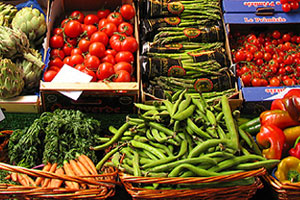
Flickr/<a href="http://www.flickr.com/photos/thepizzareview/3572925000/sizes/z/in/photostream/" target="_blank">The Pizza Review</a>
Yesterday I blogged about a USDA-funded Big Ag lobby group‘s efforts to discredit the EWG’s list of most-pesticide-laden produce. Turns out the Ag lobbyists aren’t the only industry group getting some love from the USDA: Via Civil Eats, I learned that Domino’s new cheese-a-rific pizza (40 percent more artery-clogging goodness!) and attendant marketing blitz is the result of a $12 million campaign by a USDA-backed group called Dairy Management Inc.
Really, I must say, the Dairy Management Inc. site is worth a visit—it’s a real window into the mammoth PR arm of the US dairy industry. Across the bottom of the homepage is a row of 14 buttons, which take you to dairy-cheerleading sites such as Fuel Up to Play 60 (about how you should eat more dairy so that you have the energy to exercise for an hour), ilovecheese.com (“the ultimate site for cheese lovers everywhere!”), and Innovate With Dairy (where the food and beverage producers can learn “new ways to use dairy ingredients in a wide range of on-trend product applications,” from a scientists in lab coats, no less!).
But my very favorite little nugget of all is a site called Raise Your Hand for Chocolate Milk!, which tells parents about the nefarious nutritionists who are trying to take away children’s chocolate milk:
Concerned about the added sugars in flavored milk, some schools and activists are working to ban it from school menus, despite scientific evidence supporting its nutrient contributions to children’s diets and recommendations from leading health professional organizations.
A cup of chocolate 1 percent milk has about 170 calories, compared to 120 in the unflavored version. Just saying. As Civil Eats points, out, the USDA is supposed to be curbing childhood obesity. And yet it’s also funding a group that wants to cram more calories into milk, in order to make it more appetizing to kids. Hmm.
Read nutrition journalist Marion Nestle’s take on the Raise Your Hand for Chocolate Milk campaign here.















